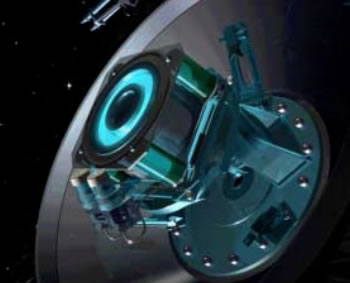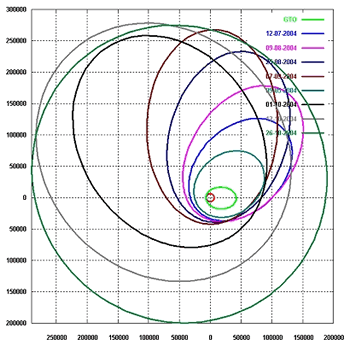Science Fiction
Dictionary
A B C D E F G H I J K L M N O P Q R S T U V W X Y Z
SMART-1's Ion Drive Not Science Fiction

SMART-1, the European Space Agency craft currently in orbit around the moon, makes use of a technology that was pure science fiction until almost 1960 - the ion drive. An ion drive is a method of propulsion that uses electricity to create charged ions and then accelerate them with a magnetic field, pushing them out the rear of a spacecraft.
The ion drive was first described in science fiction in 1947 by Jack Williamson in a short story published in Astounding Science Fiction called "The Equalizer." In the story, the spacecraft achieves a significant fraction of the speed of light, returning decades later due to time dilation, using an ion thruster.
George Lucas makes use of ion drives in Star Wars: the old Empire makes use of T.I.E. Fighters as small, manuverable spacecraft. T.I.E. is an acronym for Twin Ion Engines:
US astronaut Edward Gibson published Reach in 1989; this novel features a spacecraft with an ion drive that accelerates atoms of mercury to one percent of the speed of light before sending them out the rear of the craft.
SMART-1 has a stationary plasma thruster using xenon gas with 1190 watts of power available, giving a nominal thrust of 68 mN. The spacecraft contains 48 liters of xenon gas at 150 bar. The lifetime of the thruster is 7,000 hours at maximum power. The thrust is equivalent to two pennies resting in the palm of your hand.
The hexagonal solar panels supply power to a unique propulsion system. Microparticle accelerators propel Ionized gasses at a substantial fraction of lightspeed...
(Read more about T.I.E. Fighters)

(From SMART-1 Ion Drive)
If this seems like a propulsion system that is a bit short of "warp speed," you're right. However, in the frictionless environment of space, even a gentle acceleration like this can produce real velocity if applied constantly over a long enough period of time. Take a look at the path of SMART-1 as it gradually increased its speed, spiralling further and further from Earth before breaking free of Earth's gravity and heading toward the moon. Since a solar panel-equipped ion drive craft only carries the weight of the propellant, and can eject the propellant at significantly greater velocity, such a craft will outperform a spacecraft that uses conventional chemical propulsion over the long run. (Chemical propulsion depends on carrying the weight of the reactant chemical; the exhaust velocity is also significantly less.)

(From SMART-1 Orbital Path)
The US probe Deep Space 1 also used an ion drive, succeeding in its dual missions of flybys of asteroid Braille and Comet Borrelly in 1999. Ion drives have been used in satellites as a way of gently nudging them into higer orbits; the Irridium satellite network made use of ion drive propulsion for positioning and to prevent orbit decay.
SMART 1 has traveled a total of 80 million kilometers in 13 months to reach the moon (due to its spiraling path); Apollo 11 traveled 400,000 kilometers in four days during the first Moon landing mission. On the other hand, the washing machine-sized SMART 1 cost just $85 million.
The early history of the idea of accelerating particles electrically as a means of propulsion goes back as early as 1906, when American scientist Dr. Robert Goddard mentioned the possiblity in his research into rocketry. Dr. Hermann Oberth, a German engineer, introduced Dr. Wernher von Braun to the possibility in the 1930's, and published Possibilities of Space Flight in 1939, devoting a chapter to electric propulsion methods. It was Dr. von Braun who eventually talked NASA into working on a prototype, saying "I wouldn't be a bit surprised if we flew to Mars electrically." The basic principles of the ion drive were tested as early as 1959 at NASA's Glen Research Center; the first working drive was created in 1970. Deep Space 1, launched in 1998, was the first ion drive craft sent into space (read the final technical evaluation of its propulsion system).
The European Space Agency has a very nice website about SMART-1; along with mission objectives and updates, it includes a set of articles about electric spacecraft propulsion. You'll also find some information about ion drives and other science-fictional technologies in the short book Innovative Technologies from Science Fiction. Thanks to David Raitt for pointing these out. See also the comprehensive article Ion propulsion - over 50 years in the making.
Scroll down for more stories in the same category. (Story submitted 11/18/2004)
Follow this kind of news @Technovelgy.| Email | RSS | Blog It | Stumble | del.icio.us | Digg | Reddit |
Would
you like to contribute a story tip?
It's easy:
Get the URL of the story, and the related sf author, and add
it here.
Comment/Join discussion ( 3 )
Related News Stories - (" Space Tech ")
Will Space Stations Have Large Interior Spaces Again?
'They filed clumsily into the battleroom, like children in a swimming pool for the first time, clinging to the handholds along the side.' - Orson Scott Card, 1985.
Reflect Orbital Offers 'Sunlight on Demand' And Light Pollution
'I don't have to tell you about the seven two-mile-diameter orbital mirrors...'
Chrysalis Generation Ship to Alpha Centauri
'This was their world, their planet ó
this swift-traveling, yet seemingly moveless vessel.' - Nat Schachner, 1934
The First Space Warship For Space Force
'Each of the electrical ships carried about twenty men...' - Garrett P. Serviss, 1898.
Technovelgy (that's tech-novel-gee!) is devoted to the creative science inventions and ideas of sf authors. Look for the Invention Category that interests you, the Glossary, the Invention Timeline, or see what's New.
Science Fiction
Timeline
1600-1899
1900-1939
1940's 1950's
1960's 1970's
1980's 1990's
2000's 2010's
Current News
Golf Ball Test Robot Wears Them Out
"The robot solemnly hit a ball against the wall, picked it up and teed it, hit it again, over and again...'
Boring Company Vegas Loop Like Asimov Said
'There was a wall ahead... It was riddled with holes that were the mouths of tunnels.'
Rigid Metallic Clothing From Science Fiction To You
'...support the interior human structure against Jupiterís pull.'
Is The Seattle Ultrasonics C-200 A Heinlein Vibroblade?
'It ain't a vibroblade. It's steel. Messy.'
Roborock Saros Z70 Is A Robot Vacuum With An Arm
'Anything larger than a BB shot it picked up and placed in a tray...'
A Beautiful Visualization Of Compact Food
'The German chemists have discovered how to supply the needed elements in compact, undiluted form...'
Bone-Building Drug Evenity Approved
'Compounds devised by the biochemists for the rapid building of bone...'
Secret Kill Switch Found In Yutong Buses
'The car faltered as the external command came to brake...'
Inmotion Electric Unicycle In Combat
'It is about the size and shape of a kitchen stool, gyro-stabilized...'
Grok Scores Best In Psychological Tests
'Try to find out how he ticks...'
PaXini Supersensitive Robot Fingers
'My fingers are not that sensitive...'
Congress Considers Automatic Emergency Braking, One Hundred Years Too Late
'The greatest problem of all was the elimination of the human element of braking together with its inevitable time lag.'
The Desert Ship Sailed In Imagination
'Across the ancient sea floor a dozen tall, blue-sailed Martian sand ships floated, like blue smoke.'
The Zapata Air Scooter Would Be Great In A Science Fiction Story
'Betty's slapdash style.'
Thermostabilized Wet Meat Product (NASA Prototype)
There are no orbiting Michelin stars. Yet.
Could Crystal Batteries Generate Power For Centuries?
'Power could be compressed thus into an inch-square cube of what looked like blue-white ice'
